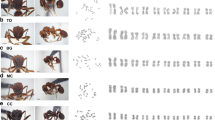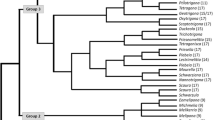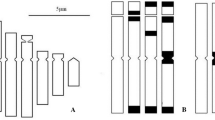Abstract
105 Australian ant species, including members of the important primitive genera Amblyopone and Myrmecia, were karyotyped using a C-banding air-drying technique. The observed haploid numbers in this survey ranged from 2n=84 (the highest known in the Hymenoptera) to 2n=9. Seven types of chromosome rearrangement were detected, namely: Robertsonian rearrangements, pericentric inversions, saltatory changes in constitutive heterochromatin, simple reciprocal translocations, complex translocations accompanied by significant loss of euchromatin, supernumerary (B-) chromosome variation, and chromosome deletion. Most ant karyotype evolution is explicable in terms of the first three of these. No evidence was found for polyploidy or centric dissociation being of evolutionary significance in ants. The C-band analysis supports a model in which pericentric inversions converting acrocentrics to other types greatly predominate over those with reverse effects. There appears to be little, if any, correlation between whether a species is morphologically primitive or advanced and its karyotype organization. The data provide little support for the ancestral chromosome number in ants having been high with subsequent reduction (“fusion hypothesis”), but rather suggest that the ancestral number was either very low with subsequent increase (“fission hypothesis”) or coincident with the present mode (“modal hypothesis”). Moreover, for these ant data, the modal hypothesis is interpretable as a subset of the fission hypothesis.
Similar content being viewed by others
References
Anonymous: Palindromes in eukaryotic DNA. Nature (Lond.) 248, 733–734 (1974)
Bostock, C.: Repetitious DNA. In: Advanc. Cell Biology (D.M. Prescott, L. Goldstern and E. McConkey, eds.) 2, 153–223 (1971)
Bradshaw, W.W., Hsu, T.C.: Chromosomes of Peromyscus (Rodentia, Cricetidae) III. Polymorphism in Peromyscus maniculatus. Cytogenetics 11, 436–451 (1972)
Bridges, C.B.: The bar “gene” a duplication. Science 83, 210–211 (1936)
Britten, R.J., Kohne, D.E.: Implications of repeated nucleotide sequences. In: Handbook of molecular cytology (A. Lima-de-Faria, ed.), pp. 37–51. Amsterdam: North-Holland Publ. Comp. 1969
Brown, W.L.: Revisionary notes on the ant genus Myrmecia of Australia. Bull. Mus. comp. Zool. Harvard 111, 1–35 (1953)
Brown, W.L.: A review of the ants of New Zealand (Hymenoptera). Acta Hymenopterologica 1, 1–50 (1958)
Brown, W.L., Taylor, R.W.: Superfamily Formicoidea. In: The insects of Australia (I.M. Mackerras ed.), pp. 951–959. Melbourne: Melbourne Univ. Press 1970
Cavalier-Smith, T.: Palindromic base sequences and replication of eukaryote chromosome ends. Nature (Lond.) 250, 467–470 (1974)
Church, R.B., Ryskov, A.P., Georgiev, G.P.: Structure of nuclear pre-mRNA. VI. “Reverse repeats” in animal DNA and their hybridization with double-stranded regions of pre-mRNA. Molek. Biologiya 8, 503–509 (1974)
Clark, J.: The Formicidae of Australia. I. Subfamily Myrmeciinae. Melbourne: C.S.I.R.O. 1951
Cooper, K.W.: Cytogenetic analysis of major heterochromatic elements (especially Xh and Y) in Drosophila melanogaster, and the theory of “heterochromatin”. Chromosoma (Berl.) 10, 535–588 (1959)
Crozier, R.H.: An acetic acid dissociation, air-drying technique for insect chromosomes, with aceto-lactic orcein staining. Stain Technol. 43, 171–173 (1968a)
Crozier, R.H.: Cytotaxonomic studies on some Australian Dolichoderine ants (Hymenoptera: Formicidae). Caryologia (Firenze) 21, 241–259 (1968b)
Crozier, R.H.: Chromosome number polymorphism in an Australian ponerine ant. Canad. J. Genet. Cytol. 11, 333–339 (1969)
Crozier, R.H.: Karyotypes of twenty-one ant species (Hymenoptera; Formicidae), with reviews of the known ant karyotypes. Canad. J. Genet. Cytol. 12, 109–128 (1970a)
Crozier, R.H.: Pericentric rearrangement polymorphism in a North American dolichoderine ant (Hymenoptera: Formicidae). Canad. J. Genet. Cytol. 12, 541–546 (1970b)
Crozier, R.H.: Hymenoptera. Animal cytogenetics (B. John, ed.), vol. 3. Insecta 7. Berlin, Stuttgart: Gebrüder Borntraeger 1975
Crozier, R.H.: Genetic differentiation between populations of the ant Aphaenogaster “rudis” in the southeastern United States. Genetica (den Haag) 46, (in press)
Flamm, W.G.: Highly repetitive sequences of DNA in chromosomes. Int. Rev. Cytol. 32, 1–51 (1972)
Forel, A.: Formicides australiens reçus de MM. Froggatt et Rowland Turner. Rev. Suisse Zool. 18, 1–94 (1910)
Hsu, T.C.: Chromosome structure a possible function of constitutive heterochromatin: The bodyguard hypothesis. Genetics 79, 137–150 (1975)
Hsu, T.C., Arrighi, F.E.: Distribution of constitutive heterochromatin in mammalian chromosomes. Chromosoma (Berl.) 34, 243–253 (1971)
Imai, H.T.: Proposal of a new criterion for the classification of mammalian chromosomes. Ann. Rep. Nat. Inst. Genetics (Japan) No. 23, 50–52 (1973)
Imai, H.T.: B-chromosomes in the myrmicine ant, Leptothorax spinosior. Chromosoma (Berl.) 45, 431–444 (1974)
Imai, H.T.: Evidence for non-random localization of the centromere on mammalian chromosomes. J. theor. Biol. 49, 111–123 (1975)
Imai, H.T.: Further evidence and biological significance for non-random localization of the centromere on mammalian chromosomes. J. theor. Biol. 61 (in press 1976)
Imai, H.T., Kubota, M.: Karyological studies of Japanese ants (Hymenoptera, Formicidae). III. Chromosoma (Berl.) 37, 193–200 (1972)
Imai, H.T., Kubota, M.: Chromosome polymorphism in the ant, Pheidole nodus. Chromosoma (Berl.) 51, 391–399 (1975)
John, B., Freeman, M.: Causes and consequences of Robertsonian exchange. Chromosoma (Berl.) 52, 123–136 (1975)
John, B., Hewitt, G.M.: Karyotype stability and DNA variability in the Acrididae. Chromosoma (Berl.) 20, 155–172 (1966)
John, B., Hewitt, G.M.: Patterns and pathways of chromosome evolution within the Orthoptera. Chromosoma (Berl.) 25, 40–74 (1968)
Keyl, H.-G.: Duplikationen von Untereinheiten der chromosomalen DNS während der Evolution von Chironomus thummi. Chromosoma (Berl.) 17, 139–180 (1965)
Levan, A., Fredga, K., Sandberg, A.A.: Nomenclature for centromeric position on chromosomes. Hereditas (Lund) 52, 201–220 (1964)
Maruyama, T., Imai, H.T.: Karyotype evolution as a stochastic process. 45th Annual Meeting Zool. Soc. Japan, Sapporo 1974
Matthey, R.: The chromosome formulae of eutherian mammals. In: Cytotaxonomy and vertebrate evolution (A.B. Chiarelli and E. Capanna, eds.), pp. 531–616. London: Academic Press 1973
Pardue, M.L., Gall, J.G.: Chromosomal localization of mouse satellite DNA. Science 168, 1356–1358 (1970)
Patterson, J.T., Stone, W.S.: Evolution in the genus Drosophila. New York: Macmillan 1952
Ritossa, F.: Crossing-over between X and Y chromosomes during ribosomal DNA magnification in Drosophila melanogaster. Proc. nat. Acad. Sci. (Wash.) 70, 1950–1954 (1973)
Schmid, C.W., Manning, J.E., Davidson, N.: Inverted repeat sequences in the Drosophila genome. Cell 5, 159–172 (1975)
Simpson, G.G.: The major features of evolution. New York: Columbia University Press 1953
Stanley, S.M.: An explanation for Cope's rule. Evolution (Lawrence, Kans.) 27, 1–26 (1973)
Thomas, C.A., Pyeritz, R.E., Wilson, D.A., Dancis, B.M., Lee, C.S., Bick, M.D., Huang, H.L., Zimm, B.H.: Cyclodromes and palindromes in chromosomes. Cold Spr. Harb. Symp. quant. Biol. 38, 353–370 (1973)
Todd, N.B.: Karyotypic fissioning and canid phylogeny. J. theor. Biol. 26, 445–480 (1970)
Wallace, B., Kass, T.L.: On the structure of gene control regions. Genetics 77, 541–558 (1974)
Wheeler, W.M.: Ants. Their structure, development and behavior. New York: Columbia Univ. Press 1965
White, M.J.D.: Animal cytology and evolution, 3rd ed. London: Cambridge University Press 1973
Wilson, A.C., Bush, G.L., Case, S.M., King, M.-C.: Social structuring of mammalian populations and rate of chromosomal evolution. Proc. nat. Acad. Sci. (Wash.) 72, 5061–5065 (1975)
Wilson, D.A., Thomas, C.A., Jr.: Palindromes in chromosomes. J. molec. Biol. 84, 115–144 (1974)
Wilson, E.O.: The insect societies. Cambridge, Massachusetts: Harvard University Press 1971
Yunis, J.J., Yasmineh, W.G.: Heterochromatin, satellite DNA and cell function. Science 174, 1200–1209 (1971)
Author information
Authors and Affiliations
Rights and permissions
About this article
Cite this article
Imai, H.T., Crozier, R.H. & Taylor, R.W. Karyotype evolution in Australian ants. Chromosoma 59, 341–393 (1977). https://doi.org/10.1007/BF00327974
Received:
Accepted:
Issue Date:
DOI: https://doi.org/10.1007/BF00327974




